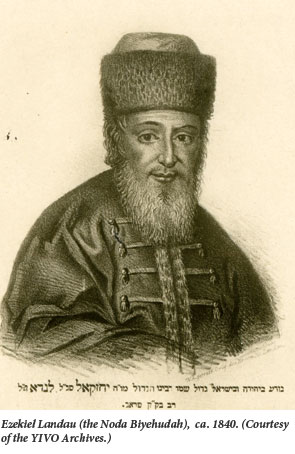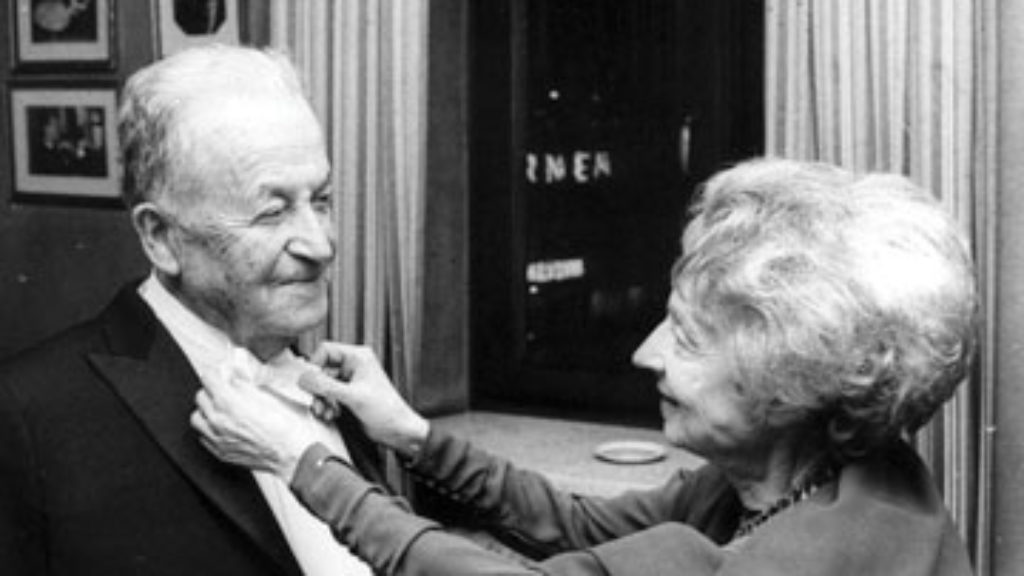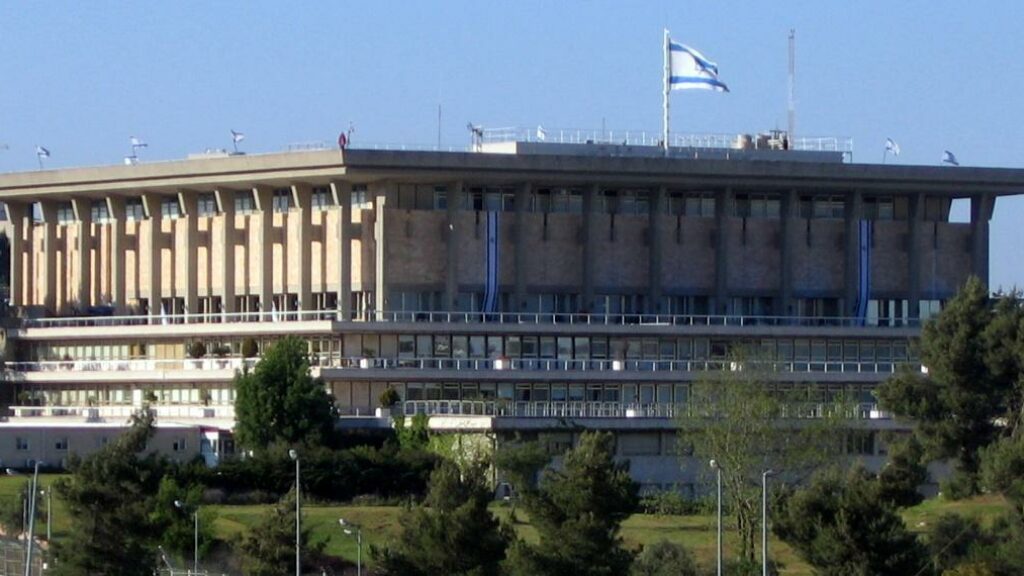The Great Non-Miracle Rabbi of Prague
From the Maharal’s mythical Golem to Kafka’s metamorphosed Gregor Samsa, Prague’s Jewish lore is suffused with mystery. While “the Maharal“ (the acronym by which Rabbi Judah Loew is commonly known), is the most celebrated of Prague’s rabbis, and the Golem he never created remains the city’s most stubbornly resilient Jewish symbol, its greatest rabbinical scholar was Ezekiel Landau, who served as Chief Rabbi of Prague and Bohemia from 1754 to 1793. Landau, commonly referred to as “the Noda Biyehudah” afterhis book of responsa, brilliantly negotiated the challenges posed to Prague’s Jews by governmental modernization and the Enlightenment. The institutions he created ensured the survival of traditional Judaism in a modernized context. However, he is remembered most for his battles with Prague’s Jewish mystics and messianists.
In her new book, The Kabbalistic Culture of Eighteenth-Century Prague: Ezekiel Landau (the “Noda Biyehudah”) and His Contemporaries, Sharon Flatto aims to revise radically the image of Landau as an antagonist of Jewish mysticism. Flatto argues that not only was Landau immersed in Kabbalah from his early years as a student in Brody, as has been well known, but that he pursued a lifelong “enterprise” to spread kabbalistic lore and practice. Flatto buttresses her argument with extensive citations from all of Landau’s writings, his sermons in particular, which are replete with kabbalistic references and terms, all of which Flatto rallies to prove her thesis.

While neither Landau’s remarkable life nor his vast published scholarship is properly remembered today, his vital leadership, over almost a half-century, as the towering religious figure of one of Europe’s largest and most important Jewish communities during the period of its critical transition to modernity, had a lasting impact on Jewish history and has only recently begun to receive the scholarly attention it deserves. In addition to Flatto’s book, Israeli scholar Maoz Kahana’s brilliant doctoral dissertation on Landau—a work that sets up a serious challenge to Flatto’s book, and to which we will return below—is scheduled to be published later this year.
Following a sketch of 18th-century Prague Jewry, the first section of Flatto’s book focuses not on Landau’s “kabbalism” but rather on his complicated responses to the emergence of the Haskalah in Central Europe. However, this too is marshaled to support Flatto’s main thesis. She argues that the historical image of Landau as an opponent of Kabbalah must be understood in the larger historical context of his battle to protect and conserve traditional rabbinic culture—which for Landau included Kabbalah—from an array of new threats.
In her tellingly entitled chapter, “Mystical and Modernizing Trends,” Flatto thus treats Landau’s responses to the Haskalah, Sabbateanism, and Hasidism as all being of one cloth, with the single, tactical agenda of protecting the primacy of halakhic practice and traditional Jewish education. She insists that Landau’s opposition to the Sabbateans and Hasidim not be confused with any general reticence, let alone hostility, towards Kabbalah as such. If Flatto’s reading of her sources were reliable, and if her use of sources were more impartial, her book would have constituted a stunning revision of the image of the Noda Biyehudahas it has emerged both in pious hagiographies and critical academic studies.
Unfortunately, Flatto’s work is essentially flawed by her unwavering determination to establish its central, governing idea, causing her to read primary sources tendentiously. She interprets Landau’s every reference to a kabbalistic idea or use of a kabbalistic term, no matter how tangential or parenthetic, as evidence of his mysticism. More grievously, she rallies every instance in which Landau endorsed, or himself practiced, customsthat originated with the advent of Kabbalah but were close to universal by the 18th century, as evidence of his passionate dedication to “spreading” and “promoting” Kabbalah.
When describing Landau’s hostility to the rise of the Hasidic movement in Eastern Europe, Flatto commits errors that are not merely exegetical. Aside from using the misleading term mitnaged—properly applied only to those rabbis in Eastern Europe actively engaged in combating the spread of Hasidism—in describing Landau (the Hasidic movement did not reach Prague in his day), her effort to categorize him is especially problematic:
Many rabbis were both involved in Jewish legal and communal matters and deeply committed to kabbalistic study and a pietistic lifestyle. The recurrent convergence of these categories, as best demonstrated by the rabbinic giants, Landau and Elijah, the Gaon of Vilna, has often been overlooked. Much of the opposition to the new Hasidim came neither from ‘the rabbis’ nor ‘the pietists,’ but rather from a group of normative rabbinic authorities, such as Landau, Emden, and Elijah of Vilna, who were both rabbis and pietists.
But the Gaon of Vilna was a celebrated ascetic, never held any communal post, and wrote monumental commentaries on central kabbalistic texts, all of which earned him the title Ha-Gaon he-Hasid. None of this can be said of Landau, who never authored an original kabbalistic work or commentary, and was hardly an ascetic recluse like the Gaon. Landau had absorbed kabbalistic influences, but this fact only puts him in the company of almost every rabbi since the expulsion of the Jews from Spain.
Flatto’s very erudition and assiduously narrow approach to the primary sources is, ironically enough, her book’s real Achilles’ heal. She seems barely able to contain her excitement at each and every encounter with a kabbalistic notion, or the offhand use of the most commonly employed terms, which she repeatedly depicts as “striking” and “remarkable” when they are nothing of the kind. Though such terms originated in kabbalistic lore, they had long become a standard part of rabbinic Hebrew. Use of words such as devekut(clinging to God), kavanah (spiritual intent in religious observance), tikun (cosmic correction attained through religious ritual), and so forth, prove only that Ezekiel Landau was an 18th-century rabbinic intellectual.
In her determination to establish that Landau was on a mission to “promote kabbalistic study and books,” Flatto relies most heavily on a small handful of haskamot, or approbations (something like elaborate book blurbs), penned by Landau for kabbalistic works. But by Flatto’s own reckoning, “of the sixty-eight approbations he wrote during his lifetime, five were for kabbalistic works.” Moreover, the importance that Flatto attributes to the genre of haskamot is problematic. Flatto herself admits that there is no evidence that Landau actually read the works he endorsed. In one case, she is driven to insist, without a shred of evidence, that “unlike some of Landau’s other approbations, in this endorsement, he asserts that he ‘saw the composed book,’ so he must have known of its kabbalistic content.” This dubious assumption is compounded by the accompanying footnote: “In this approbation Landau only praises Peretz’s treatment of aggada and musar. However I maintain that he also knew of and approved of its kabbalistic contents.”
This all reflects a surprising ignorance of the both casual and courteous manner in which such haskamot were, and are still today, both requested and granted in rabbinic society. Such approbations were routinely granted purely on the basis of the author’s reputation, or his friendship with the authority in question. In the specific case referred to above, namely of Landau’s approbation of Peretz ben Moses’ Beit Peretz, the author and Landau were close youthful colleagues in the Brody kloyz (study center), and Landau could hardly have denied him the favor of a haskamah, even had he never seen the work, just as he had done for two other members of the kloyz.
Similarly, Flatto finds great significance in Landau’s alleged support for the publication of prayer books that contained kabbalistic elements. But Prague Jews—like all 18th-century Jews—considered the Kabbalah to be an inseparable part of traditional Judaism. It is neither “striking” nor “remarkable” that their Chief Rabbi supported the publication of siddurim that included a smattering of mystical poems and references to long-accepted kabbalistic customs.
To explain Landau’s repeated protestations, especially in his later writings, that he eschewed all involvement in the nistarot(mysteries), Flatto interprets him as writing esoterically, going so far as to compare him to Maimonides as interpreted by Leo Strauss. Upon this entirely fanciful comparison, she builds a theory that Landau deliberately hid “his desire to disseminate kabbalistic ideas” which “overrides his concerns about their esoteric and potentially subversive nature.”
Unfortunately, Flatto’s reading of Landau’s halakhic responsa is just as skewed. By far the most fascinating of these legal texts concerns the permissibility of exhuming the body of an infant who died before eight days, in order to perform a post-mortem circumcision. Landau prohibits it unless it is done within a few days of the burial and before the body’s decomposition. In the course of this responsum, Landau preemptively deflects a possible objection from kabbalists who might argue that if the child possessed the transmigrated soul of an adult, he would suffer from “fear of the final judgment,” which mystics believed afflicts the adult dead when their graves are opened. Landau flatly dismisses this as superstition with no legal relevance.
Flatto, alas, completely misconstrues this resposum, incorrectly claiming that Landau permitted the exhumation on the basis of the kabbalistic doctrine of gilgul neshamot (transmigration of souls). More bafflingly, she contends that Landau’s deflection of a possible objection to exhumation based on mystical superstitions in fact constitutes proof of his devotion to Kabbalah, arguing that “he exhibits his kabbalistic proclivity here by initiating this unsolicited mystical discussion, which could have been avoided.” Flatto adds in the footnote to this bizarre claim that “the original question that prompted this responsum mentioned neither the kabbalistic doctrine ofgilgul neshamot nor the legal complexities that would result from it.” But, “the original question” is not extant, and Landau offers no more than a one-line summary of the presenting problem raised by the questioner.
Ultimately, the most serious problem among the many that plague her book is Flatto’s ahistorical and non-biographical approach to her subject. She conflates the young kabbalistic initiate in the Brody kloyz with the mature and wizened leader of a major Jewish community beset by problems created precisely by the popularization of the Kabbalah on the part of its antinomian messianic distorters. She pays absolutely no attention to the dates of the primary sources she cites, neither does she allow for the possibility that Landau’s posture towards Kabbalah might have evolved over the course of a long and stormy career. Most astonishingly, given how much credence she pays to Landau’s youthful studies in the Brody kloyz, Flatto never once mentions the change of posture of that very institution toward kabbalistic study during the height of the Frankist controversies. When Frankists provoked public burnings of the Talmud in Poland, the rabbis of the Brody kloyz, in May 1756, issued an unprecedented ban on the public teaching of the major texts of Kabbalah, including the Zohar, stating, “we prohibit anyone to study these writings, even those of ‘the Ari’ (Rabbi Isaac Luria). It is strictly prohibited to study any of them before the age of 40.”
It is precisely the careful reading of primary sources, attention to changing historical currents, and careful consideration of biographical evolution, so lacking in Flatto’s book, that distinguishes the work on Landau’s thought and times by Maoz Kahana, referred to above. Among Kahana’s great achievements is the interpretation of a major section of one of Landau’s most polemical sermons that had been censored from all published editions of the compilation Derushei Ha-Zelah. The reason for its censorship, as Kahana and his teacher, Michael Silber, conclusively demonstrate in their collaborative article in the latest edition of the Israeli journal, Kabbalah, was the controversial nature of this text’s unprecedented attack on the students of Kabbalah, particularly the practitioners of Lurianic kavanot(devotions) in Landau’s time. The censored text devotes separate but equal time to denouncing the three distinct “heresies” of Landau’s day—the Enlightenment deism of maskilim, false messianism, and kabbalism. This in itself completely undercuts Flatto’s insistence on separating Landau’s assault on the Sabbateans and Frankists from his allegedly enduring reverence for the kabbalists of his day.
The vehemence of Landau’s denunciation of practitioners of Kabbalah is in itself remarkable, as he accuses them of opening the door to idolatry by spreading doctrines such as the ten sefirot (emanations) to the uninitiated. As Landau himself attests, his polemic would shock many listeners. In the course of this sermon, Landau issues an astonishing confession regarding the “sins of his youth.” As it dramatizes precisely what is entirely missing from Flatto’s book, I will conclude my review with Landau’s own words:
There is another sect of those who, on account of our many sins, believe they are ever rising higher. If
only they will not cause a great descent! They are kabbalists of our times, those who engage in the study of the Zohar and writings of the Ari. Woe unto me if I speak out, and woe if I do not . . . If I do speak . . . I know they will say: ‘this rabbi’s heart is not complete as he lacks the merit of understanding the true secrets of Torah’ . . . As for the “true secrets of Torah” that they study, in my youth I probably knew them as well as they, and thank God who rescued me from them.
Suggested Reading

As Though the Power of Speech Were an Ordinary Matter
Moods provides glimpses into Yoel Hoffmann’s life in literature and his ambivalence about the project of capturing life in words.

Dust-to-Dust Song
Nelly Sachs was 50 years old when she fled the Nazis with her mother in 1940. Few would have perdicted that she would receive the Nobel Prize for Literature twenty-six years later.

From Place to Place in Search of a Place: Reading Agnon in Berlin
Far from his family, and searching for a sukkah, Shai Secunda found himself following Shai Agnon’s footsteps through the city of Berlin.

What Zionism Delivered
Ever since what Hillel Halkin calls my “bloc” lost Israeli elections, I have tried various therapies to manage my disappointment—and fear. I visited Susya, the ancient town near Hebron, examining…
Comments
You must log in to comment Log In